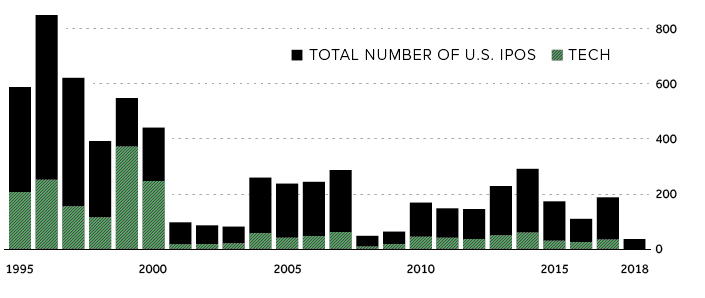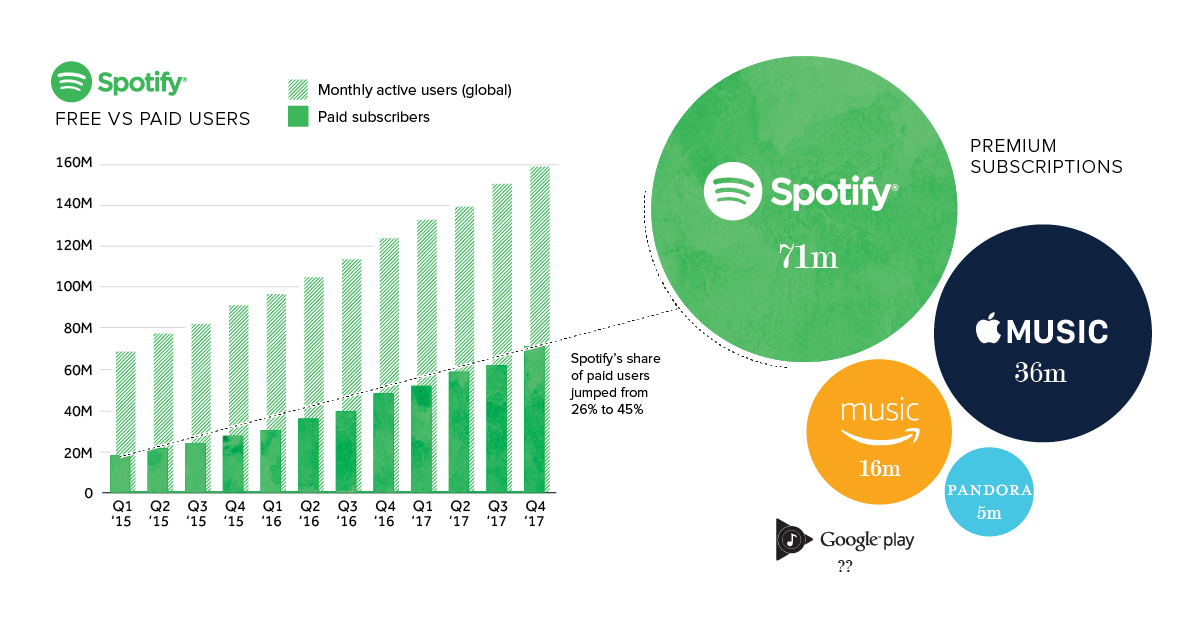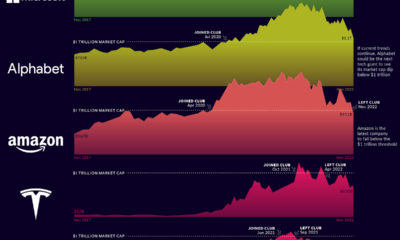On April 3, 2018, the music streaming service Spotify is expected to hit the public markets for the first time. However, while IPOs are usually large, hype-driven spectacles that involve investment bankers and roadshows to financial institutions, the Spotify IPO is taking quite a different route. For a variety of reasons, this will make the Spotify IPO both an unusual and intriguing event for investors. Here’s what’s interesting about the impending listing of the Sweden-based unicorn.
1. A Rare Breed
Despite the tech IPO being a legendary exit strategy among startup founders and venture capitalists, the reality is that today tech IPOs are few and far between.
By the same token, IPOs are also traditionally a way for investors to get a handle on market sentiment. With fewer tech IPOs on the books, it means that investors will look even closer to the Spotify IPO to try and gauge market frothiness.
2. An Unusual Listing
However, the Spotify IPO is not conventional in any respect. The company was forced to IPO as a result of an impending deadline that would have entitled existing holders of convertible debt the option to “unwind” their transactions and get new convertible notes. Further, the IPO uses an unconventional route to market – instead of the traditional investment bank and roadshow, Spotify is direct-listing its shares on the market from the pockets of existing shareholders. Based on current valuations, Spotify is the largest and highest-profile company to ever try this approach on an exchange in the United States. On the plus side, Spotify reduces its costs by going this route. On the negative, it could lead to more volatility. For better or worse, direct-listing shares places the company’s fate solely in the hands of John Q. Public.
3. An Upstream Battle
In 2017, Spotify shares sold for a vast range that places the company’s valuation somewhere between $6.3 billion to $20.9 billion. In a more recent private transaction, it put the valuation at closer to $23 billion. If the company IPOs at $20 billion, as some experts expect, it’d make the Spotify IPO one of the five biggest tech listings of all-time. However, as today’s chart shows, the company still faces many challenges. If Spotify can wrangle control of the music market and squeeze out better margins, while keeping its current growth trajectory, the Spotify IPO will be one to remember for a long time. on But fast forward to the end of last week, and SVB was shuttered by regulators after a panic-induced bank run. So, how exactly did this happen? We dig in below.
Road to a Bank Run
SVB and its customers generally thrived during the low interest rate era, but as rates rose, SVB found itself more exposed to risk than a typical bank. Even so, at the end of 2022, the bank’s balance sheet showed no cause for alarm.
As well, the bank was viewed positively in a number of places. Most Wall Street analyst ratings were overwhelmingly positive on the bank’s stock, and Forbes had just added the bank to its Financial All-Stars list. Outward signs of trouble emerged on Wednesday, March 8th, when SVB surprised investors with news that the bank needed to raise more than $2 billion to shore up its balance sheet. The reaction from prominent venture capitalists was not positive, with Coatue Management, Union Square Ventures, and Peter Thiel’s Founders Fund moving to limit exposure to the 40-year-old bank. The influence of these firms is believed to have added fuel to the fire, and a bank run ensued. Also influencing decision making was the fact that SVB had the highest percentage of uninsured domestic deposits of all big banks. These totaled nearly $152 billion, or about 97% of all deposits. By the end of the day, customers had tried to withdraw $42 billion in deposits.
What Triggered the SVB Collapse?
While the collapse of SVB took place over the course of 44 hours, its roots trace back to the early pandemic years. In 2021, U.S. venture capital-backed companies raised a record $330 billion—double the amount seen in 2020. At the time, interest rates were at rock-bottom levels to help buoy the economy. Matt Levine sums up the situation well: “When interest rates are low everywhere, a dollar in 20 years is about as good as a dollar today, so a startup whose business model is “we will lose money for a decade building artificial intelligence, and then rake in lots of money in the far future” sounds pretty good. When interest rates are higher, a dollar today is better than a dollar tomorrow, so investors want cash flows. When interest rates were low for a long time, and suddenly become high, all the money that was rushing to your customers is suddenly cut off.” Source: Pitchbook Why is this important? During this time, SVB received billions of dollars from these venture-backed clients. In one year alone, their deposits increased 100%. They took these funds and invested them in longer-term bonds. As a result, this created a dangerous trap as the company expected rates would remain low. During this time, SVB invested in bonds at the top of the market. As interest rates rose higher and bond prices declined, SVB started taking major losses on their long-term bond holdings.
Losses Fueling a Liquidity Crunch
When SVB reported its fourth quarter results in early 2023, Moody’s Investor Service, a credit rating agency took notice. In early March, it said that SVB was at high risk for a downgrade due to its significant unrealized losses. In response, SVB looked to sell $2 billion of its investments at a loss to help boost liquidity for its struggling balance sheet. Soon, more hedge funds and venture investors realized SVB could be on thin ice. Depositors withdrew funds in droves, spurring a liquidity squeeze and prompting California regulators and the FDIC to step in and shut down the bank.
What Happens Now?
While much of SVB’s activity was focused on the tech sector, the bank’s shocking collapse has rattled a financial sector that is already on edge.
The four biggest U.S. banks lost a combined $52 billion the day before the SVB collapse. On Friday, other banking stocks saw double-digit drops, including Signature Bank (-23%), First Republic (-15%), and Silvergate Capital (-11%).
Source: Morningstar Direct. *Represents March 9 data, trading halted on March 10.
When the dust settles, it’s hard to predict the ripple effects that will emerge from this dramatic event. For investors, the Secretary of the Treasury Janet Yellen announced confidence in the banking system remaining resilient, noting that regulators have the proper tools in response to the issue.
But others have seen trouble brewing as far back as 2020 (or earlier) when commercial banking assets were skyrocketing and banks were buying bonds when rates were low.

















